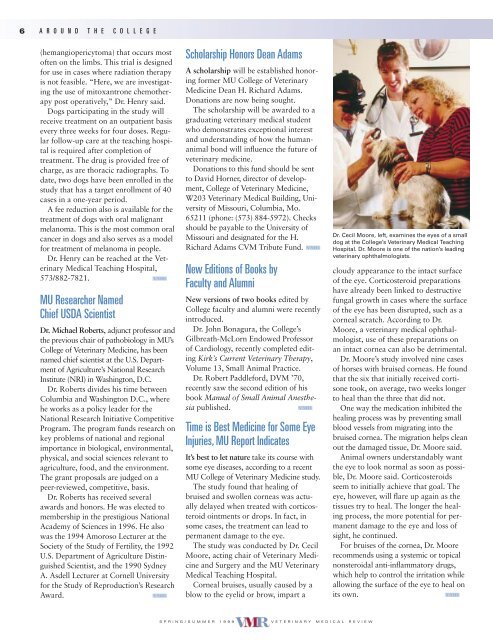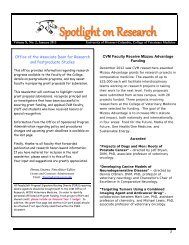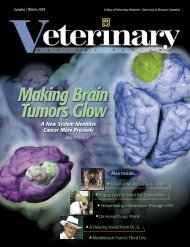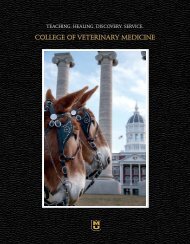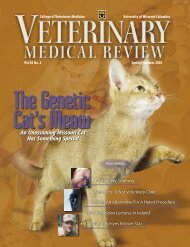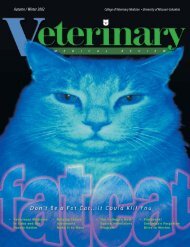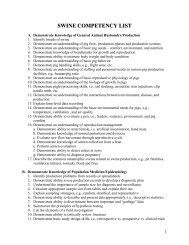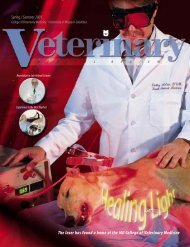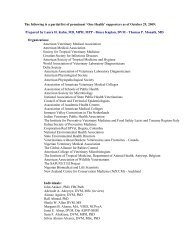... page 10 - University of Missouri College of Veterinary Medicine
... page 10 - University of Missouri College of Veterinary Medicine
... page 10 - University of Missouri College of Veterinary Medicine
You also want an ePaper? Increase the reach of your titles
YUMPU automatically turns print PDFs into web optimized ePapers that Google loves.
6 A R O U N D T H E C O L L E G E<br />
(hemangiopericytoma) that occurs most<br />
<strong>of</strong>ten on the limbs. This trial is designed<br />
for use in cases where radiation therapy<br />
is not feasible. “Here, we are investigating<br />
the use <strong>of</strong> mitoxantrone chemotherapy<br />
post operatively,” Dr. Henry said.<br />
Dogs participating in the study will<br />
receive treatment on an outpatient basis<br />
every three weeks for four doses. Regular<br />
follow-up care at the teaching hospital<br />
is required after completion <strong>of</strong><br />
treatment. The drug is provided free <strong>of</strong><br />
charge, as are thoracic radiographs. To<br />
date, two dogs have been enrolled in the<br />
study that has a target enrollment <strong>of</strong> 40<br />
cases in a one-year period.<br />
A fee reduction also is available for the<br />
treatment <strong>of</strong> dogs with oral malignant<br />
melanoma. This is the most common oral<br />
cancer in dogs and also serves as a model<br />
for treatment <strong>of</strong> melanoma in people.<br />
Dr. Henry can be reached at the <strong>Veterinary</strong><br />
Medical Teaching Hospital,<br />
573/882-7821.<br />
VMR<br />
MU Researcher Named<br />
Chief USDA Scientist<br />
Dr. Michael Roberts, adjunct pr<strong>of</strong>essor and<br />
the previous chair <strong>of</strong> pathobiology in MU’s<br />
<strong>College</strong> <strong>of</strong> <strong>Veterinary</strong> <strong>Medicine</strong>, has been<br />
named chief scientist at the U.S. Department<br />
<strong>of</strong> Agriculture’s National Research<br />
Institute (NRI) in Washington, D.C.<br />
Dr. Roberts divides his time between<br />
Columbia and Washington D.C., where<br />
he works as a policy leader for the<br />
National Research Initiative Competitive<br />
Program. The program funds research on<br />
key problems <strong>of</strong> national and regional<br />
importance in biological, environmental,<br />
physical, and social sciences relevant to<br />
agriculture, food, and the environment.<br />
The grant proposals are judged on a<br />
peer-reviewed, competitive, basis.<br />
Dr. Roberts has received several<br />
awards and honors. He was elected to<br />
membership in the prestigious National<br />
Academy <strong>of</strong> Sciences in 1996. He also<br />
was the 1994 Amoroso Lecturer at the<br />
Society <strong>of</strong> the Study <strong>of</strong> Fertility, the 1992<br />
U.S. Department <strong>of</strong> Agriculture Distinguished<br />
Scientist, and the 1990 Sydney<br />
A. Asdell Lecturer at Cornell <strong>University</strong><br />
for the Study <strong>of</strong> Reproduction’s Research<br />
Award. VMR<br />
Scholarship Honors Dean Adams<br />
A scholarship will be established honoring<br />
former MU <strong>College</strong> <strong>of</strong> <strong>Veterinary</strong><br />
<strong>Medicine</strong> Dean H. Richard Adams.<br />
Donations are now being sought.<br />
The scholarship will be awarded to a<br />
graduating veterinary medical student<br />
who demonstrates exceptional interest<br />
and understanding <strong>of</strong> how the humananimal<br />
bond will influence the future <strong>of</strong><br />
veterinary medicine.<br />
Donations to this fund should be sent<br />
to David Horner, director <strong>of</strong> development,<br />
<strong>College</strong> <strong>of</strong> <strong>Veterinary</strong> <strong>Medicine</strong>,<br />
W203 <strong>Veterinary</strong> Medical Building, <strong>University</strong><br />
<strong>of</strong> <strong>Missouri</strong>, Columbia, Mo.<br />
65211 (phone: (573) 884-5972). Checks<br />
should be payable to the <strong>University</strong> <strong>of</strong><br />
<strong>Missouri</strong> and designated for the H.<br />
Richard Adams CVM Tribute Fund.<br />
New Editions <strong>of</strong> Books by<br />
Faculty and Alumni<br />
VMR<br />
New versions <strong>of</strong> two books edited by<br />
<strong>College</strong> faculty and alumni were recently<br />
introduced.<br />
Dr. John Bonagura, the <strong>College</strong>’s<br />
Gilbreath-McLorn Endowed Pr<strong>of</strong>essor<br />
<strong>of</strong> Cardiology, recently completed editing<br />
Kirk’s Current <strong>Veterinary</strong> Therapy,<br />
Volume 13, Small Animal Practice.<br />
Dr. Robert Paddleford, DVM ’70,<br />
recently saw the second edition <strong>of</strong> his<br />
book Manual <strong>of</strong> Small Animal Anesthesia<br />
published.<br />
VMR<br />
Time is Best <strong>Medicine</strong> for Some Eye<br />
Injuries, MU Report Indicates<br />
It’s best to let nature take its course with<br />
some eye diseases, according to a recent<br />
MU <strong>College</strong> <strong>of</strong> <strong>Veterinary</strong> <strong>Medicine</strong> study.<br />
The study found that healing <strong>of</strong><br />
bruised and swollen corneas was actually<br />
delayed when treated with corticosteroid<br />
ointments or drops. In fact, in<br />
some cases, the treatment can lead to<br />
permanent damage to the eye.<br />
The study was conducted by Dr. Cecil<br />
Moore, acting chair <strong>of</strong> <strong>Veterinary</strong> <strong>Medicine</strong><br />
and Surgery and the MU <strong>Veterinary</strong><br />
Medical Teaching Hospital.<br />
Corneal bruises, usually caused by a<br />
blow to the eyelid or brow, impart a<br />
S P R I N G / S U M M E R 1 9 9 9 V E T E R I N A R Y M E D I C A L R E V I E W<br />
Dr. Cecil Moore, left, examines the eyes <strong>of</strong> a small<br />
dog at the <strong>College</strong>’s <strong>Veterinary</strong> Medical Teaching<br />
Hospital. Dr. Moore is one <strong>of</strong> the nation’s leading<br />
veterinary ophthalmologists.<br />
cloudy appearance to the intact surface<br />
<strong>of</strong> the eye. Corticosteroid preparations<br />
have already been linked to destructive<br />
fungal growth in cases where the surface<br />
<strong>of</strong> the eye has been disrupted, such as a<br />
corneal scratch. According to Dr.<br />
Moore, a veterinary medical ophthalmologist,<br />
use <strong>of</strong> these preparations on<br />
an intact cornea can also be detrimental.<br />
Dr. Moore’s study involved nine cases<br />
<strong>of</strong> horses with bruised corneas. He found<br />
that the six that initially received cortisone<br />
took, on average, two weeks longer<br />
to heal than the three that did not.<br />
One way the medication inhibited the<br />
healing process was by preventing small<br />
blood vessels from migrating into the<br />
bruised cornea. The migration helps clean<br />
out the damaged tissue, Dr. Moore said.<br />
Animal owners understandably want<br />
the eye to look normal as soon as possible,<br />
Dr. Moore said. Corticosteroids<br />
seem to initially achieve that goal. The<br />
eye, however, will flare up again as the<br />
tissues try to heal. The longer the healing<br />
process, the more potential for permanent<br />
damage to the eye and loss <strong>of</strong><br />
sight, he continued.<br />
For bruises <strong>of</strong> the cornea, Dr. Moore<br />
recommends using a systemic or topical<br />
nonsteroidal anti-inflammatory drugs,<br />
which help to control the irritation while<br />
allowing the surface <strong>of</strong> the eye to heal on<br />
its own. VMR


